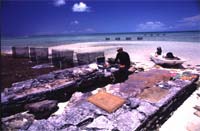After a 7-year interplanetary voyage, NASA’s Cassini spacecraft will reach Saturn this July and begin what promises to be one of the most exciting missions in planetary exploration history.
After years of work, scientists have just completed plans for Cassini’s observations of Saturn’s largest moon, Titan.
“Of course, no battle plan survives contact with the enemy,” said Ralph Lorenz, an assistant research scientist at the University of Arizona’s Lunar and Plan
High tech tools may help find solutions to animal-human conflicts in the sea — Sea turtles, porpoises, albatrosses and tunas could see brighter days ahead
How can scientists follow leatherback sea turtles that dive to crushing depths a half-mile below the surface and swim across 80% of the world’s ocean? Or tunas that race faster than most boats? Or albatrosses that soar halfway across the Pacific without sleep or a meal — unlike their human observers? Science is beginning to m
British scientists set sail today from Glasgow to begin work aimed at discovering if Britain is indeed in danger of entering the next ice age.
Scientists on the Royal Research Ship Discovery are on their way to deploy oceanographic instruments across the Atlantic Ocean from the Canary Islands to the Bahamas. The instruments will spend the next four years measuring the temperature, salinity and speed of currents.
The work is part of a research programme called Rapid Climate Change, f

Scientists agree that coral reefs are in an alarming global state of decline. However, determining the main cause or causes of this decline has proven a much more contentious issue. In the current edition of the Journal of Experimental Marine Biology and Ecology (JEMBE), Harbor Branch marine scientist Dr.Brian Lapointe and colleagues present new evidence they hope will help settle one major debate: whether pollution or overfishing is the main cause of the coral-smothering spread of seaweed on many re
The convergence of information and communication technologies into a national “cyberinfrastructure” is poised to revolutionize the environmental sciences and many other disciplines in the coming years, according to researchers presenting at the AAAS Annual Meeting in Seattle. The two Feb. 13 sessions on cyberinfrastructure were organized by the heads of two National Science Foundation (NSF) directorates.
The speakers will describe a very near future in which computing capabilities will pr
The transformation of terrestrial and coastal ecosystems by humans is well known, but only recently have the impacts of anthropogenic forces in the open ocean been recognized. In particular, intense exploitation by industrial fisheries is rapidly changing oceanic ecosystems by drastically reducing populations of many marine species. For most oceanic species we lack a historical perspective.
In an important article to shortly appear in Ecology Letters, Baum and Myers demonstrate that the ini